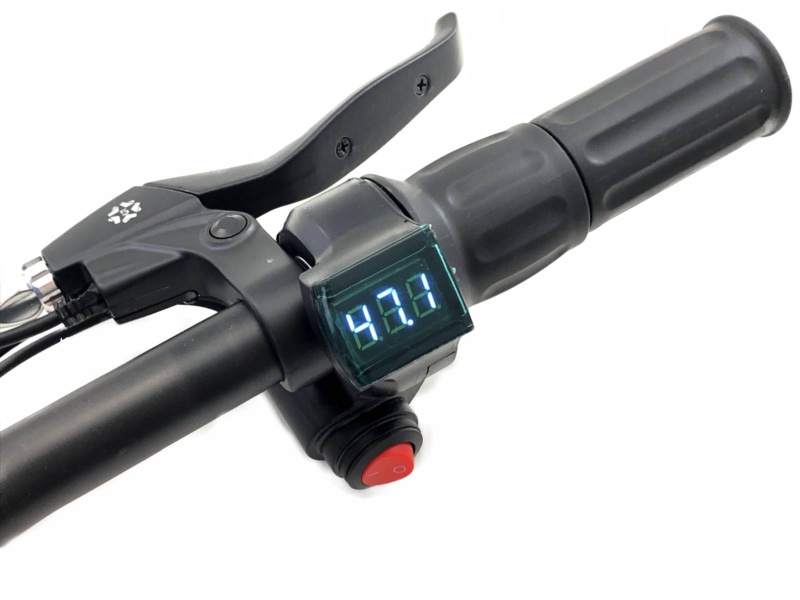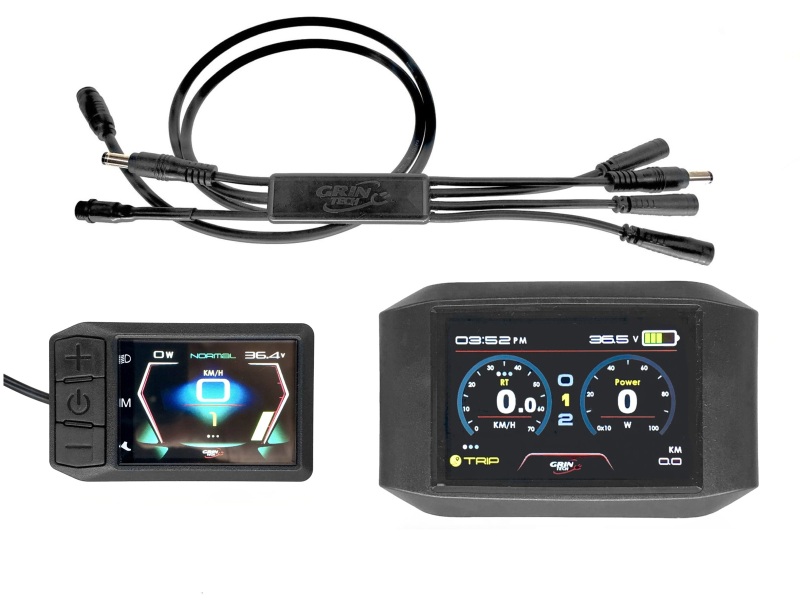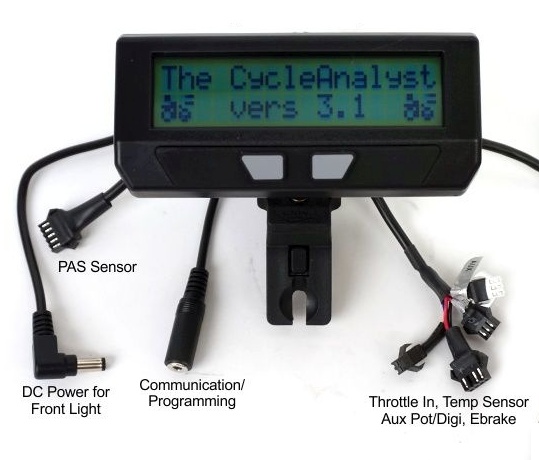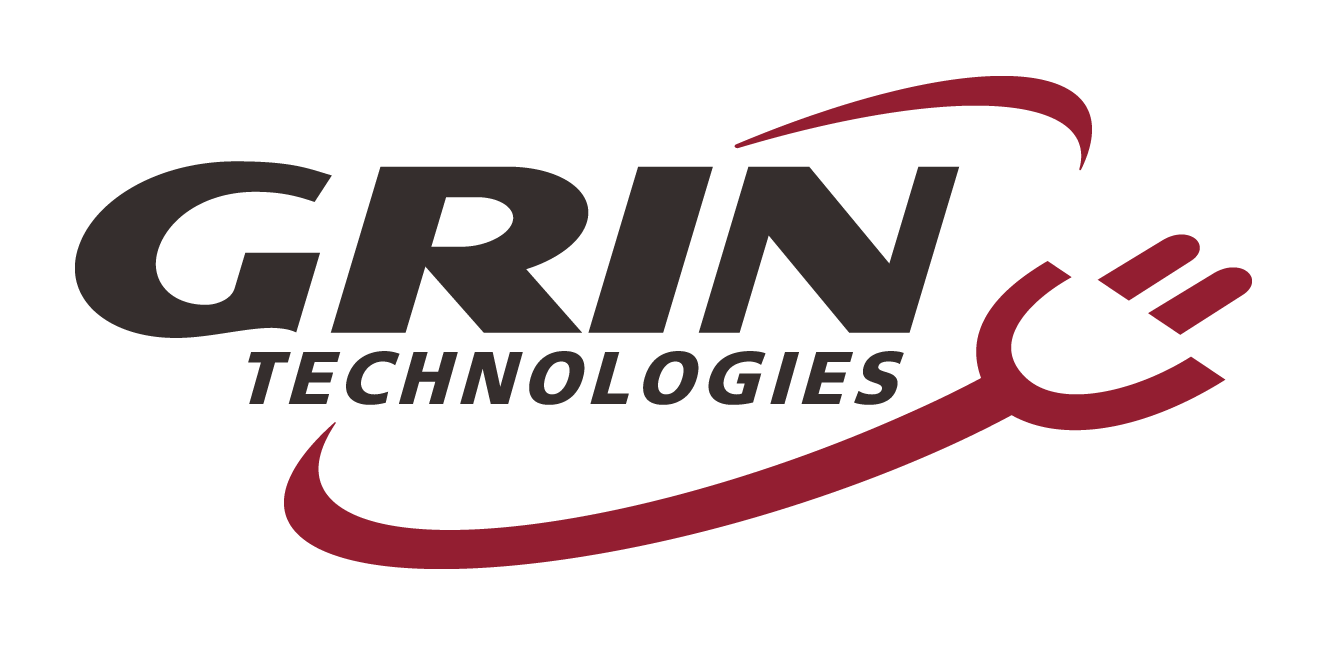Kit Types
Here at Grin we've got many hub motor models available to service all the different needs people have for motor performance. Once you've chosen the motor model, you then need to determine which of three kinds of kit to buy. Every hub motor that we list is available to buy in a Barebones Kit, a Superharness Kit, or a Cycle Analyst Kit.
Three Kit Styles
 |
 |
 |
| Barebones kits use an all-in-one throttle with a simple 3 digit voltage readout. For a twist and go setup with no pedal assist sensors, it's a simple and easy way to setup an ebike. | Superharness kits have a special Mains cable harness and employ conventional ebike displays on the handlebar for a mainstream friendly but fully featured system. They can support torque and PAS sensors along with throttle and variable regen. |
Cycle Analyst kits have been the mainstay of Grin's kit system for many years. They originate from when motor controllers were not very sophisticated, so we had all throttle, pedal, and ebrake sensors going into our Cycle Analyst circuit for processing. They are a great platform for the technical DIY builder who don't mind an older character display in exchange for lots of functionality |
Summary Table
Here is a table summarizing the difference in features between each kit style:
| Barebones Kit | Superharness Kit | Cycle Analyst Kit | |
| Throttle Control | ✓ | ✓ | ✓ |
| Option for PAS Control | ✗ | ✓ | ✓ |
| Option for Torque Control | ✗ | ✓ | ✓ |
| Multple Assist Levels | ✗ | ✓ | ✓ |
| Basic Regenerative Braking? | ✓ | ✓ | ✓ |
| Proportional Regen Braking? | ✗ | ✓ | ✓ |
| Backpedal Regen Braking? | ✗ | ✗ | ✓ |
| Display Battery Voltage | ✓ | ✓ | ✓ |
| Displays Speed, Distance | ✗ | ✓ | ✓ |
| Displays Electrical Power | ✗ | ✓ | ✓ |
| Displays Amp-hours, Wh/km | ✗ | ✗ | ✓ |
| Displays Motor Temperature | ✗ | ✗ | ✓ |
| Displays Human Power / Cadence | ✗ | ✗ | ✓ |
So which model should you get? If you are somebody who just wants a clean ebike with a twist throttle to go and no clutter on the handlebars, then that is easy, the barebones kit is the one for you.
Otherwise, you'll get to choose between a setup based around our classic V3 Cycle Analyst, or a system with a typical ebike display and the Superharness.
Differences between CA3 System and Superharness System
Both the Cycle Analyst setup and a Superharness setup will give you options for pedal cadence sensors or torque sensors in addition to the throttle, with the ability to set up various levels of assistance. They also both have displays showing all the basics like your speed, power draw, battery charge level etc.
There are core differences in how this functionality is implemented from the system design and how customizable they are, and that may influence which style you get. A simple answer is
a) Get a CA3 based kit if you have a technical background and are interested in nerding out with your system
b) Get a Superharness kit if you couldn't care to learn about amp-hours, and simply want an ebike display that just shows the familiar essentials (speed, assist level, and battery charge)
What follows is a much more detailed point by point breakdown of the differences.
Pedal Sensor Hookup
With a Cycle Analyst system, the pedal sensors plug into the display, so the display is fully aware of what's going on with your pedalling effort and it's the display that configures how the motor should respond. The motor controller has no idea that there is a pedal sensor in the system, it just responds as though there was a throttle. All setup is done by the CA3 display.
In a Superharness setup, the pedal sensor plugs into the motor controller. All configuration of how the pedal sensor works needs to be done through the motor controller parameter using a computer, and the display is totally unaware of your pedaling. During operation, the display 'talks' with the controller to tell it what assist level the rider has selected, and the controller adjusts the pedal response accordingly.
User Customizability
The superharness kits are supplied with settings 'as-is', just like all factory ebikes or kits from other companies. The pedal assist and throttle behavior is configured to what we think is appropriate for the motor at hand and there is no expectation that you will change this.
Although we provide the software tools and communication wire for advanced users to change all motor controller parameters, there is no implicit support from Grin for you to do that.You will need to be comfortable using the ports of your computer and potentially troubleshooting IT issues like computer COM port recognition, as we cannot provide support for such.
With a Cycle Analyst system, almost all meaningful control behavior can be configured via the 2 button interface to the Cycle Analyst setup menu. There is no need for a computer hookup and that makes it more straightforward to help people change and customize the ebike's control behavior to what they want.
Ability to Change Settings On the Fly
With a Cycle Analyst, all settings are configurable via the two button display interface. You have the ability to change and modify the behavior at any point without needing to hook up to a computer or smartphone. You can also see via the setup menu the state of all the electrical signals for any first order troubleshooting.
On a Superharness kit, the behavior is set up in the motor controller parameters, and those can only be accessed and changed with a computer hookup. So normally it would be configured once with the desired settings and then that's just how it is.
Connector Plugs
For both historic and customizability reasons, the Cycle Analyst uses the small JST-SM signal connectors for all accessory hookups. These connectors are not intrinsically waterproof and some people think they look a bit janky, but they are user-crimpable, quite reliable, and allow for custom length wiring.
The Superharness kits use the popular Higo miniB (or equivalent) ebike connectors widely deployed in generic ebikes systems. These are overmolded waterproof plugs and they look clean. But they can be damaged if jammed in carelessly, they can't be added to a cable, and are more difficult to troubleshoot.
Because of these differences, we carry a separate line of Higo throttles and ebrakes for Superharness Systems, and JST throttles and ebrakes for CA3 based systems.
Lighting Control
The Cycle Analyst includes a DC power port for running a front bike light. Power is present on this port whenever the Cycle Analyst is turned on. A rear light can be hooked up either with a splitter cable or with a 9-pin to DC rear light cable off the controller.
The Superharness kit is more flushed out and contains two DC power ports which can be controlled directly from the display. The rear port has several modes allowing it to be used as a brake light and/or as a blinking rear light as well.In both cases the lights and accessories are expected to run at full ebike battery voltage. The use of 12V or 6V lights requires a step down DC-DC converter.
Speedometer Accuracy
The speed that is shown on the superharness kits from in a circuitous route. The motor controller 'tells' the display how long each wheel rotation takes via the communication pins every half a second. The superharness takes this information along with the input wheel diameter to compute and show speed. But the wheel diameter can only be input at the nominal level, ie 24", 26", 27.5" etc. You cannot put in the actual precise circumference of your exact tire, which can lead to errors of up to 5%.
In a Cycle Analyst setup, the CA3 itself directly receives speedometer signal pulses and allows you to set your wheel circumference to the nearest mm. As a result it is both more accurate and more immediately responsive to changes in speed.
Power Display
The Cycle Analyst measures the power draw of the motor controller by amplifying voltage drop across a precision 1mOhm shunt resistor. This is extremely accurate over a very wide current range. It allows the CA3 to precisely accumulate how many amp-hours or watt-hours have been taken from the battery pack, and it lets you see even small changes in current like you have from turning on or off your bike lights.
With a Superharnress kit, the motor controller tells the display how much battery current is flowing to the nearest 1/3rd of an amp over the communication bus, and it's basing this off a hall effect current sensor and not the more precise shunt resistor. As well, the controller firmware attempts to scale this to show output motor power and not input power, so the watts and amps the display shows are also about 20% less than actual.
High Voltage Compatibility
Both the CA3 systems and our Superharness can operate at up to 90V to provide support for 72V systems when using the Phaserunner motor controller. However, with the Cycle Analyst there is a limit in how much current can drive the accessories in a high voltage setup. In practice, that means most torque sensors can't be hooked up to the CA3 directly at 72V. If a torque sensor is required it must be powered from an independant 12V supply and only the signal fed to the CA3.
Since the superharness kits use the internal 12V DC-DC converter of the motor controller for powering the PAS / Torque sensors, there is no special consideration when using them at 72V, as long as you are using a 72V compatible display from Grin.
Troubleshooting / Diagnostics
Because the Cycle Analyst has all accessories hooked up to it, it can show the voltage signals present on the display to inform you what is going on for troubleshooting system hardware. These signals are all displayed either as voltages or up/down arrows in the respective setup menu screens.
On the Superharness systems, we similarly did our best to show the user what is going on via the three indicator LED lights. They will turn on and glow in various brightness levels depending on the state of the signal voltages, which can help alert to a break in the wiring or a defective component. However, the PAS / Torque sensor signals and motor temperature signals do not connect to the superharness, so troubleshooting those requires a computer connection to the motor controller.
Regen Control
Both the Cycle Analyst and Superharness kits make use of a single wire throttle + regen signal to the motor controller, where values over 1V are for positive power, and voltages below 1V signal increasing regen braking.
With a Superharness kit there are 3 options available for varying the regen brake force based on the plugs available.
a) With an digital brake cutoff sensor to engage regen
b) With a proportional brake sensor (or 2nd throttle) that can directly vary from 1-4V depending on how far the lever is pressed
c) with a Bidirectional throttle that twist one way to accelerate, and another for regen braking.
With a Cycle Analyst kit, support for proportional brake levers and bidirectional throttles is not yet available but is foreseen in the final V3.2 firmware release. However the Cycle Analyst provides several additional modes to control regen not available with a superharness kit. All three of these modes require V3.2 beta3 or later firmware
a) Speed Limit Regen control - You can set a speed at which regen will kick in and adjust automatically to govern, independently of the max speed for power
b) Back-pedal Regen Control - With this feature enabled a backwards rotation of the pedals will automatically activate regen, and the further back you rotate the cranks the more regen you get. It quickly becomes an intuitive mode with pedal assist ebikes, just like the coaster brakes of our youth
c) Digi-Aux Regen Control - The Cycle Analyst allows you to have negative assist levels, where you can go below 0 assist to have increasing amounts of regen braking from the up/down digi aux buttons. This is a great mode for using regen on long downhill stretches, as you don't need to hold the throttle or brake lever and can continue pedaling and even add to the regen energy recapture.
Walk Assist Mode
Walk assist is a feature to use when pushing an ebike up a hill so that you can still use the motor at a walking speed.
On the Superharness kits this is conveniently accessed by pressing and holding the DOWN assist button.
With a Cycle Analyst system that has a pedal sensor there is no built-in walk mode. But a similar feature can be implemented by setting the max throttle-only speed to 6 kph, and then you can use the throttle when walking beside the bike and not worry about it going too fast.
Ebike Analytics
The Cycle Analyst by its namesake was designed to be an analytic instrument. It was originally developed (in 2005) as a tool to precisely measure the amp-hour and watt-hour consumption of early prototype ebikes. As the functionality of the CA increased over time, so did the number of metrics to include:
-Current, Average, and Maximum vehicle speed
-Average and Instant Wh/km
-Regen braking amp-hours and %regen recapture
-Current, Average, and Peak Motor Temperature
-# Battery cycles (incremented with each trip reset)
-Instant and Average pedal cadence (rpm)
-Instant human pedal power (watts), plus total human energy input (Wh)
The data is not only saved on the device, it is also streamed at 1Hz or 10Hz on a serial communication port for those using it as a lab instrument. Most ebike riders of course don't really need or care for that.
The Displays on the superharness systems show what you would expect from a mainstream ebike display. That includes speed and trip distance data like you would expect from a regular bike computer, plus the battery voltage and motor power.
Solar Systems
Both the Superharness kits and the CA3 kits can be wired up for solar battery charging, as can just about any ebike that doesn't use a proprietary locked battery BMS. With a superharness kit you would require a separate instrument to monitor and review the solar charging power. On a V3 Cycle Analyst system, you have an option to install custom solar fimrware and additional current sensor that displays the solar charge power in realtime on the main handlebar display.
Changing from One Style to Another
What happens if you start off with a barebones kit, but later decide you want to add a torque/pedal sensor? Or you got a Superharness kit, but find out you really want the speed limit regen feature only available with a V3 Cycle Analyst?
The good news it that it is no problem at all to purchase just the missing hardware and convert your kit to the other form
Barebones to CA3
If you want to upgrade from a Barebones kit to a CA3 based kit, you will need to purchase the CA3+MFSwitch, a new JST Throttle, and whatever PAS Sensor or Ebrake sensor you want. No change to the programming of your motor controller is required
Barebones to Superharness
If you want to upgrade from a Barebones kit to a Superharness kit, you will need to purchase the Superharness, a new Higo throttle and Higo ebrake, and optionally a Higo PAS or Torque sensor. You will also need to have a USB->TTL programming cable to reconfigure the motor controller for display communications, setup the PAS mode behavior, and potentially upgrade to the 6.025 controller firmware if your phaserunner or baserunner is running 6.023.
Superharness to CA3
In order to go from a superharness kit to a CA3 based kit, you will need to purchase the CA3+MFSwitch, and either reterminate your throttle and ebrake plugs to JST connectors or replace them. You will also require the 6 pin Higo to 5 pin JST extension cable to hook up your PAS or Torque sensor to the Cycle Analyst
CA3 to Superharness
Going the other way, if you are starting with a CA3 kit and want to have a typical display instead, you will need to purchase the Superharness, a KM5s display, and Higo terminated throttle and ebrakes. You may also need to update the firmware on your Baserunner or Phaserunner controller to 6.025 and change the parameter settings.
Superharness AND CA3
Finally, you can in principle have both a Cycle Analyst and a Superharness with 3rd party display hooked up at the same time. In this configuration, the throttle voltage output of the superharness will always override that of the Cycle Analyst. So it will behave just like the original Superharness kit and respond to throttle and pedal sensors accordingly, while the CA3 will just display the voltage, speed, amps and amp-hour data. Settings on the CA3 won't have any effect on how the system performs.


 Canadian
Canadian